Yesterday morning I made my “grieving trip” to Antelope Island after the fire. It’s something I knew I had to do but I wasn’t looking forward to my first experience with the devastation so I decided to get it behind me as soon as possible. I was able to see some of the damage from a distance but most of the island won’t be accessible until today so I just drove around the north end, talked to a few park personnel and then headed for home.
I was in a low mood – besides the devastation to the island I’d seen there had been very few birds. I wondered if the smoke had driven many of them off the island, even from areas that hadn’t burned.
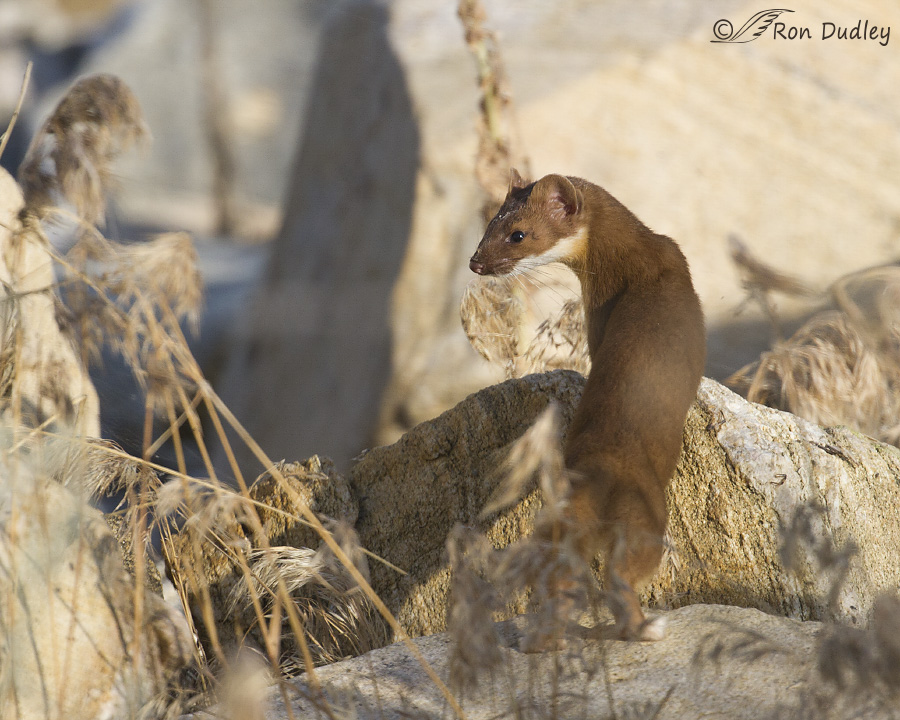
1/1600, f/6.3, ISO 400, Canon 7D, Canon EF 100-400mm f/4.5-5.6L IS II USM @ 400 mm, not baited or set up
But along the causeway on my way to the mainland this weasel ran across the road in front of me and saved the day. I pulled over and was able to get a few shots of it as it hunted for voles among the rocks and vegetation. Typical of weasels it had boundless energy as it hopped and flowed into and out of crevices and it was usually partially or completely hidden from my view.
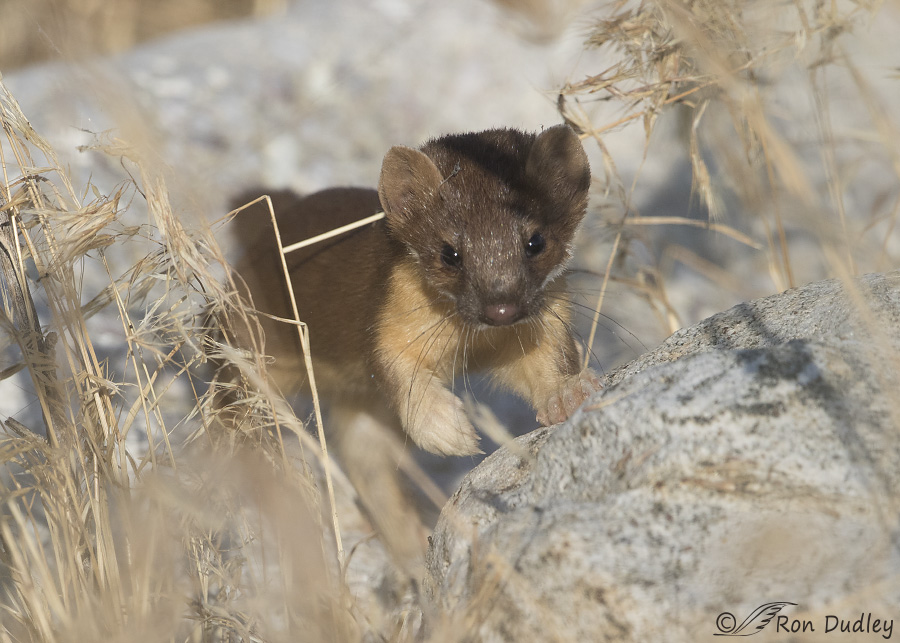
1/3200, f/6.3, ISO 500, Canon 7D Mark II, Canon EF 500mm f/4L IS II USM + 1.4 tc, not baited or set up
Talk about a difficult subject to lock focus on! I have more soft shots of this little speed demon than I care to think about. Here the weasel is coming right at me but with that long body only its face is relatively sharp.
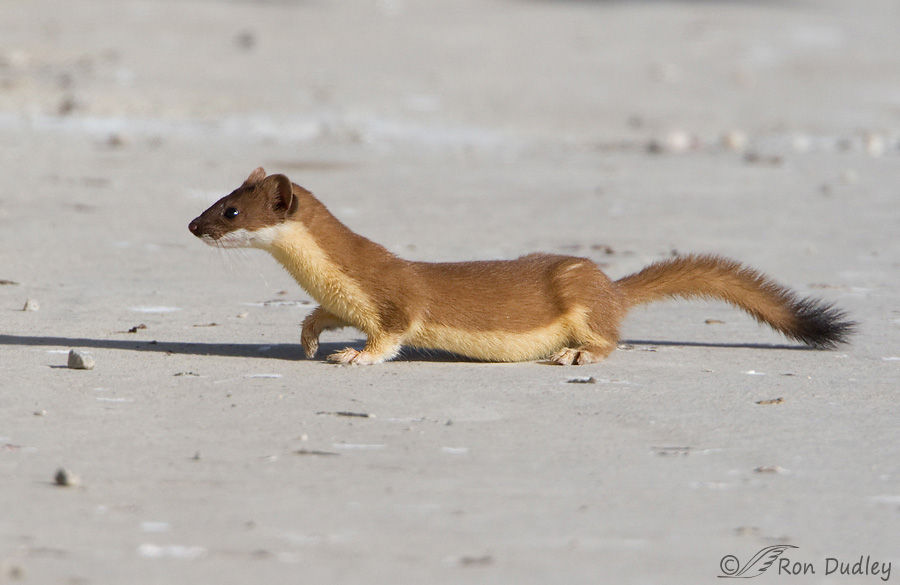
Every weasel I’ve photographed in Utah over the years has been a Long-tailed Weasel like this one from a few years ago at Bear River MBR. Utah has two weasel species – the Long-tailed Weasel and the Short-tailed Weasel. Each of them has black-tipped tails in both their summer and (white) winter coats. There’s a third North American weasel species called the Least Weasel but it’s smaller than the other two, it doesn’t not have a black-tipped tail and it isn’t supposed to be found in Utah.
I’ve researched multiple range maps for Least Weasels and none of them show the show Least Weasel in Utah – the closest seems to be eastern and central Montana.
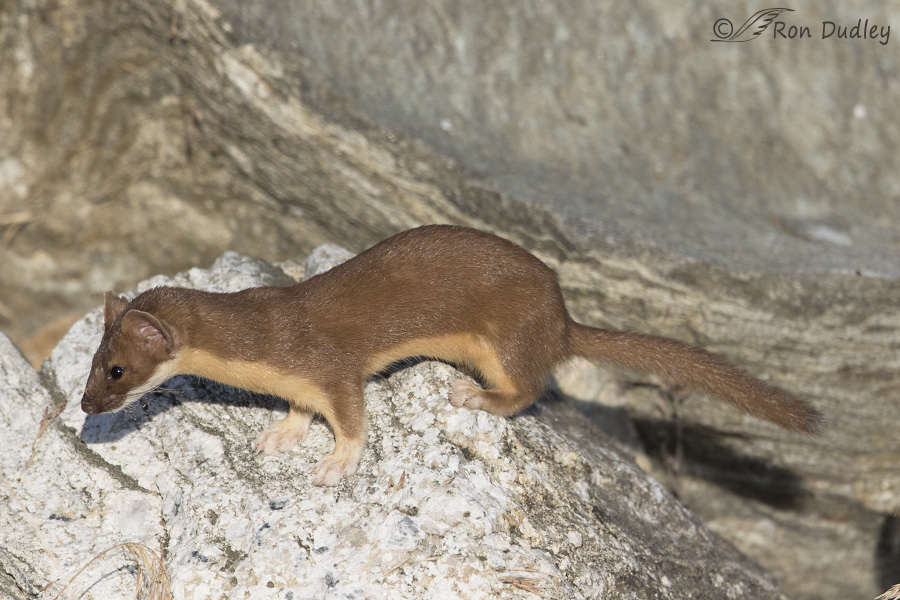
1/5000, f/6.3, ISO 500, Canon 7D Mark II, Canon EF 500mm f/4L IS II USM + 1.4 tc, not baited or set up
But the weasel I photographed yesterday didn’t have a black-tipped tail! And it seemed a little smaller than most adult weasels I see (though I can’t be sure of that).
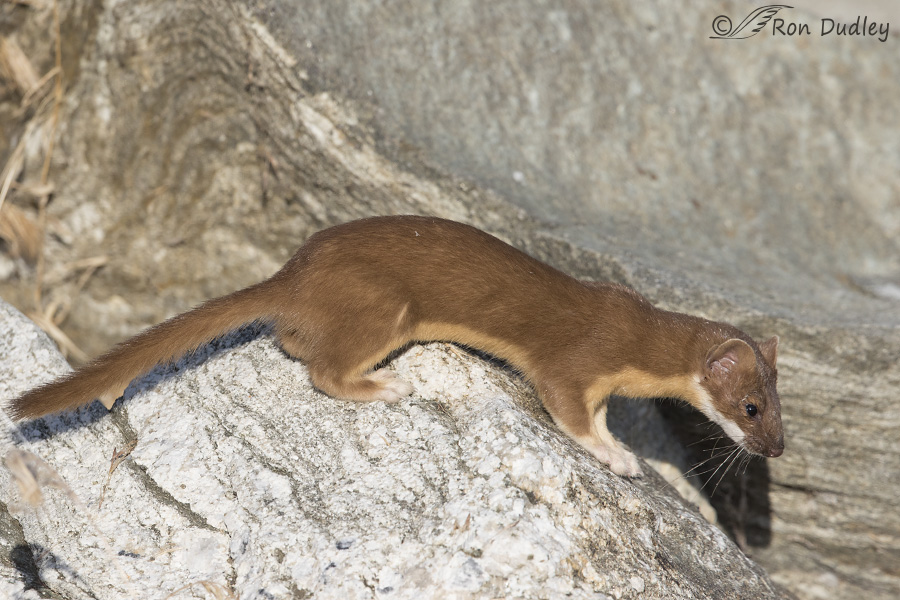
1/2500, f/6.3, ISO 500, Canon 7D Mark II, Canon EF 500mm f/4L IS II USM + 1.4 tc, not baited or set up
At any angle this weasel didn’t display a black-tipped tail. Some sources say that Least Weasels can (occasionally) have a slightly darker tail-tip but they never have black there – this one had none (both of the previous images are full frame, thus the less than ideal composition).
I can only think this might be a Least Weasel far out of its “normal” range. The only other explanations I can think of are a genetic anomaly or perhaps some predator bit the tip of its tail off but both seem unlikely.
Though I’m a retired zoology teacher I’m certainly not a carnivore or mustelid specialist so I’d welcome any and all feedback on the subject from those in the know, one way or another.
Ron
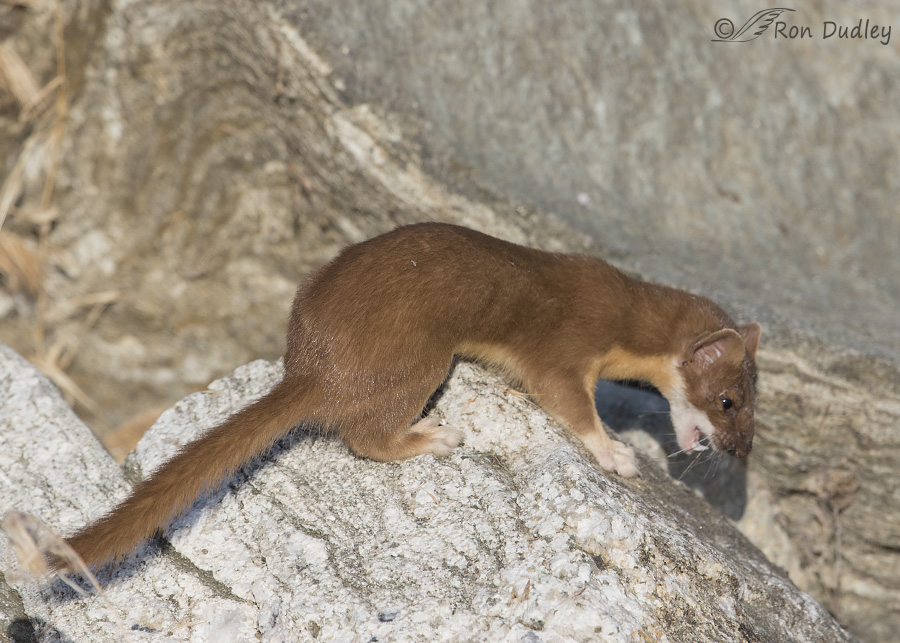
1/2500, f/6.3, ISO 500, Canon 7D Mark II, Canon EF 500mm f/4L IS II USM + 1.4 tc, not baited or set up
PS – here’s a bonus shot that shows some of those impressive teeth (though the head isn’t particularly sharp). For me this image has a feline look – with that long tail and the threatening look with the teeth showing the weasel reminds me a little of a miniscule Mountain Lion.
Yes, I’m easily entertained…


Glad you weren’t ‘skunked’ with your trip Monday since this cool weasel gave you something to shoot some great pics. I’ve never seen a weasel out there so I am intrigued by it and will begin looking for them. Great pics! Wayne Reynolds
Regardless, it is absolutely adorable, and you got in some good shots!
Thanks, Jean. I’m actually not particularly disappointed it wasn’t a Least Weasel. I’m mostly relieved to have the mystery solved.
How I love that the birds and animals don’t read where they should be. I notice that your educated commentators tell us that this is probably a long-tailed weasel in disguise. Which doesn’t alter the fact that the birds and animals go where suits them.
I am amazed by those looooong bodies, and love the miniature mountain lion look.
Weasels are amazing mammals, EC, and that long body is just one of their interesting traits, both physical and behavioral.
I believe the mystery has been solved. Sam Zeveloff posted a link to my blog on an e-list of mammal researchers and received several responses, including one from a mammal expert at the Smithsonian.
The consensus seems to be that this is a Long-tailed Weasel missing the normal black tip of its tail. Both its tail and its skull are too long for it to be a Least Weasel and the color of its ventral surface also indicates Long-tailed.
The missing black tip of the tail could have been caused by accidental loss or by genetic variation.
I enjoyed this little mystery while it lasted but I’m happy to have it (apparently) solved, thanks to Sam and his correspondents.
Great weasel captures. I hope it turns out to be a least weasel. It looks like your 7DII is back in operation.
“It looks like your 7DII is back in operation.”
I wish it were, Doc, but it actually goes into the shop this afternoon. It still focuses well when the subject is close and I have good contrast so I’ve been using it under those conditions.
Super shot Ron, never heard of or saw this species before. You even got incoming shot and shot with teeth showing. Awesome!
Thanks, Tin. That’s my first image showing teeth of any weasel species.
YEAAAA!!!! Finally, a Least Weasel, I think, for the very reasons you talked about, small, short tail and no black tip to its tail. Great shots by the way!!
This is proof that the Least Weasel lives in Utah, and I hope you have sent a picture to the appropriate wildlife individuals.
Wonderful comparisons between Long-tailed and Short-tailed along with good habitat shots.
Many thanks for sharing!
I thought of you when I posted this, Dick. You’ve been calling for more weasel photos for quite some time.
Appearances are SO deceiving! Thanks for clearing up the mystery! Long-tailed it is!
Least Weasel, Northern Pygmy Owl, Least Sandpiper…do I see a trend here?
Good pick-up, Arwen. You’re right!
…as it hopped and flowed…that’s nice Ron!
Thanks for noticing that Susan, it’s exactly what these sinuous little critters do!
Hi Ron,
These are incredible photos, and this looks like a least weasel! If so, as you mentioned, it would reveal a significant range extension. Are there any size estimates, even in comparison to the rocks etc. in the photos?I am a mammalogist on the faculty of Weber State, and author of “Mammals of the Intermountain West” (1988). I’d like to post this link with the photos on an ‘e-list’ of mammal researchers to get opinions. Any concerns about this?
Sam Zeveloff
Sam, go for it. I’d love to get the feedback. I’m on Antelope Island right now so this comment has to be short.
Which is least remarkable, and thus most likely? A least weasel with a yellow belly, a least weasel in Utah, or a long-tailed weasel with it’s tail tip missing?
Your question is out of my league, RSP, so I’ll leave it to you and others to answer it.
Sam, I’m home now. I hesitate to estimate size. That becomes even trickier with the spatial confusion caused by shooting through several lenses of different magnification.
All I know is that my very first thought when I saw this weasel on the road was that it seemed remarkably small. At that time I thought it might be a youngster.
Wonderful find and shots Ron! Congrats!
Charlotte
Thanks, Charlotte.
I hope you find a multtude of critters as healthy looking as this one on your beloved island to ease the ache that must be in your heart…I worried especially about the young and the older, slower critters…I know that this aftermath, tallying up the destruction, time can be brutal!!! My heart aches just thinking about it…don’t think I could stand seeing it…..
Patty, I spent the morning on the island again today. I have at least some good news to report, which I’ll probably do here on my blog very soon.
What a beautiful and healthy looking animal. I love the head on shot, light in the eyes….tip of the nose. Thank you also for the zoology 101. If I had traveled this same road, I probably would never have gotten much of a look except when it scurried across the road.
Thank you, Carol. I was lucky to find this one again in the rocks after it crossed the road.
The sheen on its fur seems to indicate either an extraordinary state of good health or the vitality of a youngster—-but I can’t imagine a juvenile
sporting teeth like those !—Like you ,the first thought I had upon seeing that last image was COUGAR head !
Kris, I’ve noticed that sheen on many of the weasels I’ve photographed. Not sure why…
Whatever kind of weasel this little guy is, they are great shots! Before I read your comments, I was caught by the similarity to a mini mini mountsin lion resemblance, too.
Once again, we think alike, Patty. Condolences to you for that…
Thanks for condolences–Could be worse…I think I’ll survive…
Also not an expert. I am questioning whether the belly color on a least weasel should be all white. Could this be a Long Tailed Weasel that has lost the tip of it’s tail? Remarkable find and even more remarkable that you should have such good photos of this one!
Could be Kathy – good point. I just don’t know…
Beautiful shots, Ron! Only thing I know about them is tho beautiful, they can be VERY vicious! At least you had a treat for a sad day.
Only thing I know about them is tho beautiful, they can be VERY vicious! At least you had a treat for a sad day.
Yes, Judy, this little guy provided an uplifting end to an otherwise depressing morning.
The teeth, never knew they were that big, one I would prefer to keep distance.
Agreed, Steven. I certainly wouldn’t try to pet one…
I am not an expert on this subject either, but when I was looking at pictures of the various types of weasels, the thing that stands out to me is that in photos of the Least Weasel, the brown back goes directly to a white belly. Ditto for the Short-tailed Weasel. Based on the coloration, I would tend to land in the Long-tailed camp. That said, I don’t know how consistent coloration is in Weasels. I’ve been learning not to worry too much about range, especially if the area where you find an animal is reasonably close to the known range. As others have said, animals go where they want to go. Whatever it is, these are interesting photos of a beautiful animal. I’m glad you had an experience to redeem seeing the after-effects of the fire.
Thanks, Susan. I appreciate your thoughts on this.
I guess I don’t really have to have my mouth closed to be able to type… Any shots of this elusive, constantly on the move,
hyper, little predator are always good to get, but to get shots of this quality… well lit, tack sharp, beautifully composed..
well that is just amazing. I still contend that you are from somewhere out in the universe, and stopped off at earth, just
to show us mere mortals how to take fantastic photos of “critters.” “And that’s all I have to say about that,” at least
for the moment… Great captures Ron, of a very difficult subject!! ;-)))
A difficult subject they are, Roger. Thank you.
Roger–once again, you spoke my thoughts far better than I could! Thank you…Patty
Very neat images of the weasel Ron! I am not an expert, however it looks like you may have found a Least weasel. Not sure if you heard of the wolverine (weasel family) recently found in the Sierra Nevada, it too was found far from its believed range. I really like the last image, it does look like a little mountain lion
Yes, I read about that wolverine yesterday, Ed. Pretty darned neat. A FB friend of mine recently photographed one in Glacier NP.
Once again another Zoology 101 session on your blog. One of the reasons that I check my emails the first thing each morning. ThAnks for continuing to be a good teacher.
Thanks very much, Mark!